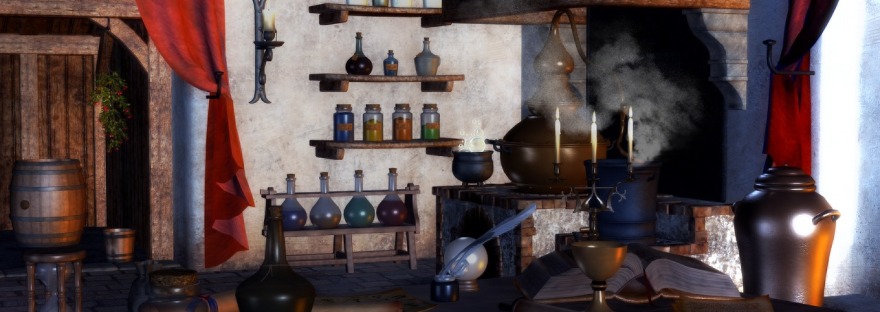As I have been researching some of my posts, certain names pop up and draw my attention and Nicneven was one that caught my eye. I have traveled in Wales and Ireland, so it seems natural that I should spend a little time in Scotland. What was really exciting about this Goddess, is that she was thought of as Queen of Witches as well as the Queen of the Fairies. Since I have just completed the final book in my series that touches on the world of the Fae, the timing on this research was a little more than coincidental.
When I started my digging for Nicneven, a reference to the Fairy Queen of Elphame came up and, as these things go, the two names were intertwined by reference to another name, Cailleach. The focus of this post will be on Nicneven and the Fairy Queen of the Elphame, but I felt it was important to mention Cailleach by reference in this post as well, especially since they are linked by a common holiday.
Let’s head off to Scotland!

Origins of Nicneven
In Celtic traditions, Samhain marks the end of the harvest season and is celebrated October 31st (aka Halloween). It is considered the start of a new year on the pagan calendar, when the veil between worlds grows thin, and the living can communicate with those who have passed. It is also a time to rectify any issues that are holding you back and allows everyone a chance at a fresh start. The Goddess Nicneven is tied to this festival and ushers in the winter, much like the Cailleach Béara or Hag of Béara who is part of the Great Goddess trinity (Maiden, Mother, Crone).
Nicneven seems to be used interchangeably with Cailleach, who is known in Scotland as the Queen of Winter. Because of this, both Nicneven and Cailleach are tied to the festival of Samhain which is when the harvest dies off, and the days grew shorter. It was believed that paying Nicneven honor would ensure a mild winter. They would spend their weeks awaiting the day when Bride (aka Bridget) would bring a new growing season (Imbolc) and the cycle of maiden, mother, crone would begin anew.

Nicneven governed the realms of magick and witchcraft, and her themes like most of the other Goddesses we have talked about are protection, divination and ghosts/spirits. Her symbols include pumpkins and gourds, which were often carved for protection and used to illuminate the path for a spirit’s transition. She is a Goddess that moves easily between worlds, and is said to fly through the air accompanied by flocks of honking geese.
She was sometimes thought of as the mother witch and was referenced by Sir Walter Scott as “A gigantic and malignant female, the Hecate of this mythology, who rode on the storm and marshaled the rambling host of wanders under her grim banner.” – Letters on Demonology and Witchcraft (1931). The reference to her being a “Scottish Hecate” makes complete sense here, since Hecate was also seen as a triple goddess. I believe they are all versions of a core belief system, and as the blending of cultures and religions took place, the Gods or Goddesses morphed into what society would allow.
It was believed that Nicneven was able to transfer water into rocks and sea into dry land, and as Cailleach she is credited with making a number of mountains and large hills by having stones drop from her apron or basket as she traveled across the land. It is not clear who her consort was or if she had children, but she was very much tied to the seasons and the harvest cycles of the Earth. In that way, she was seen as a mother goddess to all people, much like Frigg in Norse mythology. She has also been tied to the Gyre Carling, Black Annis and Haberot, for anyone who would like to research those links a bit further.
Origins of Fairy Queen of Elphame
So you might be wondering where the Fairy Queen of Elphame ties into witchcraft. Frankly, I was too, until I came upon an article by Natalia Klimczak, Meetings with the Queen of Elphame: A Magical and Protective Fairy Queen, in which she references the legend of Thomas the Rhymer (c. 1220 – 1298). It seems that Thomas was a local prophet that was said to have been given his gift by the Queen after he spent several years in her world. Where it gets really interesting is that a few hundred years later, during the witch trials that traveled throughout Europe, the Queen of Elphame was once again referenced by those who were on trial. It was their stories that cemented not only their fate, but also the idea that the Fairy Queen was tied to witchcraft and, in turn, the devil.

The name “Queen of Elphame” means “Queen of Fairyland,” and it isn’t clear when she first appeared in legends. She morphed over time, much like other goddesses, into a deity with a great deal of power and the ability to move between worlds with ease. In 1597, Andrew Man was accused of practicing magic when word got out about his healing abilities. He didn’t help himself much during his confession, when he claimed his powers were a gift from the Queen of Elphame, with whom he had intimate relations. He dug himself deeper when he explained that he had first met her when he was a boy, but didn’t have sex with her until 28 years later when they ran into one another again. She had several children by him, and in return she enhanced his ability to heal, and added power to steal milk from cows (of all things) and divine the future. It seems that his powers were similar to those granted to Thomas the Rhymer, but it was unfortunate that with all his power of prophecy, that he wasn’t able to see the flames in his future.
The Queen made appearances to women as well, a farmer’s wife by the name of Isobel Gowdie was one of them. She lived a quiet life until she fell under suspicion of practicing witchcraft. It was not uncommon for women to be accused of being in the league with the Devil over minor transgressions, but like Andrew Man, she provided a detailed confession of how she and her coven were given supernatural powers from the Queen of the Fairies. They were able to shape-shift into animals, fly on brooms made of corn stalks, and she even boasted of casting hexes on naughty children. The strange thing was even after her admission, there is no record of her execution, and she was said to have vanished without a trace.
Witchcraft in Scotland today
At the front of the entrance to Edinburgh Castle, the Witches Well on the Esplanade marks the spot where many women were burnt for witchcraft. There is also a stone structure known as Maggie Wall’s Memorial just outside the small village of Dunning. While it is unknown if Maggie Wall truly existed, her monument still stands as a reminder of the injustices that took place hundreds of years ago.

There is also a Beltane Fire Festival that takes place on April 30th on Calton Hill in Edinburgh, but be warned you might get more than an eyeful as some participants believe clothing is optional. For those who would like to welcome summer in a little more tamely, you could dance around a may pole in the comfort of your own backyard, I found a post that goes through some of the dos and don’ts of building your own.
I hope you enjoyed learning a little more about these Goddesses, I know I sure did! I have included some clips below as well as some other links that will give you more information on the Fairy Queen of Elphame should you be interested. As always, feel free to link to more resources in your comment below.
In the meantime, stay tuned for future segments! We will be travelling to other places around the globe to check out Goddesses of Witchcraft in other cultures. To make it easy, I have started an index of my #MythicalCreatureMonday posts which you can link to here.
Who has been your favorite Goddess so far? Be sure to let me know if the comments below! Happy Reading! XO
The Fairy Queen of Elphame
Other resources to check out
Nicnevin: The Scottish Witch Mother by: Kelden
https://www.shca.ed.ac.uk/Research/witches/reading.html
https://ebooks.visitscotland.com/ghosts-myths-legends/culloden-ghosts/


You must be logged in to post a comment.